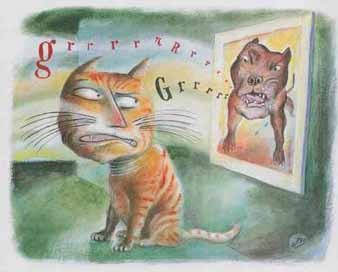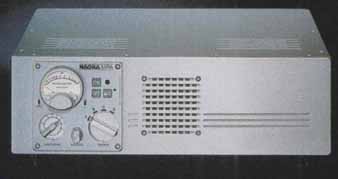Just so you don’t think I like to leave you hanging, wondering what comes next after I’ve fed you a bunch of teasers, it’s up date time—especially timely when it involves something as potentially earthshaking as NXT.
While I’d rather not be thought of as one of NXT’s publicists, it’s worth noting that you should actually be able to buy finished, shop-ready NXT flat speakers even before this column sees print. The flat-panel revolution, a hot topic for the last couple of years, is happening. So, who’s first to the post with commercially available panels? The Verity- owned Mission? Nope. It’s actually Wharfedale, Mission’s former sister company.
I’m writing this approximately eight weeks before Audio hits the stands, so it’s a bit like mixing up hindsight and foresight, but bear with me. On my desk is an invitation to Wharfedale’s upcoming NXT Roadshow ‘98, a to-date series of exhibitions around the U.K. It’s a week away at the time this is being written, so I’ve had to beg some details even though a press embargo is in place. Compromise, therefore, was required on Wharfedale’s part, while I in turn promised not to unveil too much. In other words, t can tell you only as much as ‘Wharfedale has revealed “unofficially” at this point.
One thing I can report, though, is the company has trademarked the name LoudPanels, which is a much cooler name than NXT. Another is that the two debut models are pretty much finalized. What’s most interesting, though, is that Wharfedale has unashamedly published the frequency response—unlike certain other key players. Instead of pretending, as others might, that NXT panels are full-range designs capable of doing justice to Charles Mingus at full whack, Wharfedale quite openly discusses them as reproducing the mid- band and treble regions.
It’s like this: The WXT-04 is the ceiling-tile version of Wharfedale’s NXT flat-speaker debut, a square panel 23½ x 23½ inches (595 x 595 mm) that looks exactly like the stuff in many offices with suspended ceilings. And it’s only 1 inch thick, so it can be treated just like the ordinary, mute panels it replaces. You simply lift out the old one and drop in the LoudPanel. Not being a builder, I can’t say if 23½ x 23½ inches is a standard size for Europe, but I’ll assume it is; I also presume that Americans will be offered whatever is the U.S. standard ceiling-tile size, specified in inches.
As for the hi-fi stuff, the WXT-04 (remember, it fires down at you) has three taps for adjusting levels. You can set up the speaker for ratings of. 1 1/4, 2½, or 5 watts, and sensitivity is stated at 78 dB SPL for 1 watt at 1 meter, 75 dB for 1 watt at 2 meters, and 72 dB for 1 watt at 3 meters. Given those specs, you’re right to assume that the WXT-04 is designed to supply public-address system announcements, background music, and other similar needs. Indeed, this speaker is also described as providing “100-volt line operation.” Its stated frequency response? An honest 200 Hz to 18 kHz.
And then there’s the WXT-06, the one that looks like a painting and can even hang on the wall. [Note: Wharfedale will sell it in the U.S. as the Picture Panel]
The promotional literature states quite clearly that “it is recommended that these panels be used in systems which also include a Wharfedale powered subwoofer.” That’s because the WXT-06 has a frequency response of 250 Hz to 18 kHz. How’s that for honesty?
The WXT-06 differs in many ways from its ceiling-mounted sibling. Its driving elements are two 25-watt Wharfedale transducers attached to the aluminum-core laminate panel. Size differs as well: The WXT-06’s dimensions are about 23½ x 12½ x 1¼ inches. In addition, you can decorate it with any paper print affixed to the panel with “a normal mounting adhesive.”
Then there’s the pricing. Given that the official announcements were being held until the date of the NXT Roadshow, I am permitted to say only that the price for the first panels will be “under £500” (approximately $850), but that Wharfedale is hoping to bring it down even further. Frankly, I don’t think price is going to matter one bit to those who have been screaming for years for speakers that disappear into the room, take up no floor space, and don’t look like wooden boxes. No bass below 200 Hz? Big deal. For interior designers and decor-obsessed wives everywhere, these speakers are the answer to their prayers. And for us audiophiles? To be frank, it all depends on how much we’re forced to compromise.
Now, what about the Euro launch of DVD? Don’t worry: It’s under control. Sony handed out Zone 2/PAL copies of Jerry Maguire to the assembled hacks at its Spring 1998 press conference, and we eagerly awaited the first Euro-spec DVD players for review. To that end, I hastily begged for first dibs on Pioneer’s luscious DVL-909 LD/DVD combo player, a videophile buddy in the U.S. having informed me that it’s the combo player to own.
Well, the combo player was just what the doctor ordered, especially as its laserdisc portion plays both NTSC and PAL discs, while my present player is NTSC-only. The 909 has every feature I could want and more, plus it looks terrific, and even I can afford one. When it arrived, the good John Bamford of Pioneer said: “Don’t worry, K.K., it’s identical in every way to the machines that will be in the shops—with one exception. This one runs on 240 volts and it plays PAL laserdiscs, but it’s, uh . . . Zone 1. NTSC Zone 1.”
He reassured me a few times, perhaps overly concerned, that the visuals would be identical to the PAL ones. But he worried needlessly. It wasn’t really an issue, as I was concerned mainly with the sound quality.
Whatever, I’m hooked on the 909, though I hasten to add that it hasn’t softened my hatred of the evil swine in Holly wood who thought up the zoning feature. Oh, and I still haven’t seen the Zone 2/PAL version of Jerry Maguire…
Now about Nagra, the manufacturer that still has me wishing that I had a spare $9,000 or so for its jewel-like PL-P preamplifier. True to its word, the company has come up with the goods in the amplifier department (it was introduced in June in the United States). But Nagra’s debut power amp is not the single-ended triode, 845- equipped gem we saw in Las Vegas at January’s Consumer Electronics Show. No sir. Rather, the Swiss firm has followed the PL P with the Nagra MPA, a MOS-FET power amp. The MPA is rated at 250 watts per channel into 8 ohms in Class-AB mode, which the company feels should be enough to drive any speakers on the market. How ever, provision has been made to enable the MPA to produce even more power (probably because Nagra is used to dealing with the sort of partially deaf animals that in habit recording studios). Thus, the amp can be bridged for mono operation to deliver a very meaty 500 watts (into 4 or 16 ohms). Also reflecting Nagra’s familiarity with the professional sector are studio-grade construction and balanced XLR connectors.
More in keeping with domestic concerns, though, is the option of ordering the MPA with remote-control and multiple input options. This enables infrared selection of four input sources as well as remote control of volume, balance, and mute. And a Nagra wouldn’t be a Nagra without one of the company’s famous modulometers on the front panel: On the MPA, it provides a read out of the output power in watts, referenced to two separate scales.
If the MOS-FET topology of the Nagra MPA strikes some of you as curious, especially because the PL-P preamp (and the other new power amp, for that matter) is shamelessly of the tube persuasion, I have been reassured by an esteemed colleague that the MOS-FET is, in certain quarters, a flavor of the month/year. I suspected that MOS-FETs were creeping back into accept ability; Nagra’s choice of them for the company’s first power amplifier confirms it.
As for the Eurovision Song Contest I reported on in June, well, those of you whose interest was piqued by my report on Europe’s singularly most embarrassing annual attempt at re-creating the Ted Mack Original Amateur Hour will get a kick out of this year’s results. The winning song was, as usual, an instantly forgettable slice of glossy Europop. The winning country (drum roll please): After three hours, and the tabulating of votes from 100 million viewers, the closely contested affair ended with Israel pulling ahead of Malta and Great Britain in the very last round. It was the nation’s third time at the podium.
While the winning song may have been forgettable, the drop-dead gorgeous victor was not. The Gaultier-clad chanteuse, all long limbs and glistening teeth and luxurious black hair and ruby-red lips and— ahem, er, sorry—collected the prize amidst much cheering and revelry.
Oh, but there was also much wailing and gnashing of teeth, too, for the winner, songstress Dana International (crazy name, crazy gal), is a 26-year-old former drag queen who stands 6 feet 3 inches tall. Why “former”? Because Ms. International, born Yaron Cohen, has had the operation that makes her the first-ever transsexual to win the Eurovision Song Contest.
While young Israelis were waving flags and hooting and hollering across the land when International’s name was announced—just like crowds in any victorious country—many in the Israeli establishment were not too pleased. Wrapped up in Israel’s 50th-anniversary celebrations, some (especially the ultraright wingers) didn’t re act well to the country being represented globally by a surgically modified citizen.
On the contrary, however, they should have been pleased. After all, there aren’t that many Eurovision winners who can boast of having been Bar Mitzvahed....
Adapted from 1998 Audio magazine article. Classic Audio and Audio Engineering magazine issues are available for free download at the Internet Archive (archive.org, aka The Wayback Machine)


